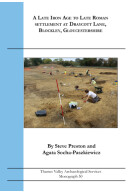Google Books previews are unavailable because you have chosen to turn off third party cookies for enhanced content. Visit our cookies page to review your cookie settings.
Middle Bronze Age to Iron Age Occupation and a Roman Field System at Cerney Wick Farm, Cerney Wick, Gloucestershire (Paperback)
Imprint: Thames Valley Archaeological Services
Series: TVAS Occasional Paper Series
Pages: 56
ISBN: 9781911228431
Published: 16th March 2020
Script Academic & Professional
Series: TVAS Occasional Paper Series
Pages: 56
ISBN: 9781911228431
Published: 16th March 2020
Script Academic & Professional
Usually available in 6-8 weeks.
You'll be £13.00 closer to your next £10.00 credit when you purchase Middle Bronze Age to Iron Age Occupation and a Roman Field System at Cerney Wick Farm, Cerney Wick, Gloucestershire. What's this?
+£4.99 UK Delivery or free UK delivery if order is over £40
(click here for international delivery rates)
Order within the next 9 hours, 4 minutes to get your order processed the next working day!
Need a currency converter? Check XE.com for live rates
(click here for international delivery rates)
Order within the next 9 hours, 4 minutes to get your order processed the next working day!
Need a currency converter? Check XE.com for live rates
Excavations within the Cerney Wick Farm quarry complex revealed a landscape occupied from the Middle Bronze Age through to the Post-Medieval period. The chronology of the occupation episodes is supported by radiocarbon dating. The earliest feature was a small ring ditch, dated to 1695-1604 cal BC. A small later Bronze Age settlement comprised four post-built roundhouses, pits and postholes. There is a suggestion of Later Bronze Age-Early Iron Age activity with a gully and possibly a contemporary post-built roundhouse.
In the Middle Iron Age a small farmstead was established, comprising a roundhouse and land divisions. This was replaced by a new roundhouse set within an enclosure in the Middle to Later Iron Age.
Roman occupation is sparse with a suggestion of a field system and a few boundary ditches. In the Post-Medieval period the area was intensively utilized with a trackway and water meadow system. The agricultural regime then changed with a late version of ridge and furrow overlying the water meadows.
Other titles in the series...
Other titles in Thames Valley Archaeological Services...










